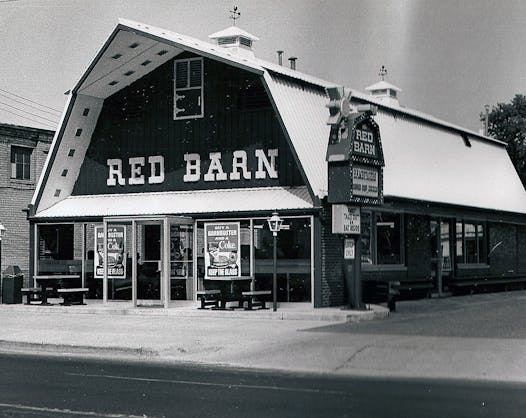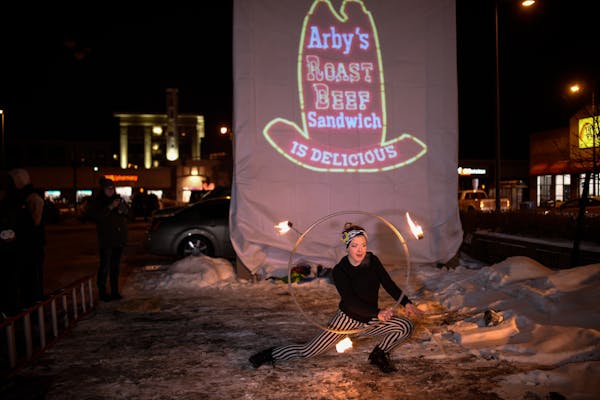The Red Barn might have been the ugliest fast-food chain to come to town.
In fact, when a Red Barn was proposed for Dinkytown in 1970, there were riots. Students occupied the buildings that had been slated for demolition, and the Red Barn was never built.
Of course, there was a Red Barn across campus in Stadium Village for decades.
It didn't fit in with the buildings around it. It wasn't designed to.
The Red Barn, like other fast-food franchises of its time, was a ridiculous, kitschy and very loud rebuke to the serious architecture of the day.
And that's what made them great.
In the 1960s, there were two basic camps of architecture. One produced serious, severe buildings that looked like rational boxes for serious men with black glasses reading IBM computer manuals.
The other created exuberant, even garish buildings that introduced a playful modernism. (Think Las Vegas glamour and Space Age design.) Some of the most outrageous urban designs of that era came from companies that sold fries and soda.
Consider the early McDonald's. With those huge golden arches, the red-and-white building, its roof thrusting upward, McDonald's represented the future — a bright and bold future. And it was, in a way, a cue for other fast-food chains to cut loose. Few had the spirit of the original McDonald's, but these fast-food joints ended up being distinct from the boxes built for every other purpose.
Kentucky Fried Chicken outlets looked vaguely Southern, with a hint of a church steeple. Taco Bells gave a nod to Spanish Mission style. And Red Barn, well, it was shaped like a barn.
Many other commercial buildings put up in the 1950s or '60s could have been interchangeable — a hardware store? Grocery store? Hobby shop? But you knew a burger joint when you saw it.
You still do.
Even when they've been repurposed, there's something cocky and loud about the old designs.
There's a unique building at 65th Street and Penn Avenue S. in Richfield. With its broad glass windows, barrel roof and overhang, it looks like an updated version of a Conestoga wagon. Even though it served as a used car showroom, you could tell by looking at it that it once sold fast food. Arby's fast food, to be exact.
You can still tell a Pizza Hut from the '70s. Its oddly pinched roof (which looks like a lid that a giant could lift up to see what's cooking inside) is still identifiable.
The grandfather of them all, of course, is the White Castle.
There's a restored White Castle at 33rd Street and Lyndale Avenue S. in Minneapolis. The building, a peculiar box with turrets, looks like a stacked bouncy-tent you'd rent for a kid's birthday. If you knew nothing about that building's history, you'd likely guess that it sold burgers, because our eyes have been trained to read "fast food" when we see a design that's happy and ridiculous.
But only if you're a certain age.
Modern fast-food joints now rely on the logo — not the architecture — for branding.
Why do I say that? Quick: Picture a Chick-fil-A. What do you see? The red logo. That's it.
The surviving fast-food joints of the golden age will be lost eventually. Most are gone now.
The Red Barn in Stadium Village was torn down years ago, having spent its last few years as a Vietnamese restaurant. You could always tell it had been something else, once.
There was a recent candlelight vigil for the Arby's sign in Uptown.
The folks who gathered to mourn might have been tongue-in-cheek, but the irony concealed a genuine sense of loss. It wasn't the closing of a roast-beef chain that saddened some. It was the loss of the sign.
The big, ugly hat sign was a remnant of an era when inordinately large hats sufficed as icons. The hat said "Out West," and that meant good ol' cowboy cooking.
Over time, the Arby's signs came down. They might have been expensive to maintain, probably a liability in a high wind, too old-fashioned.
What's the big deal? It's just a sign. And it's not like there aren't others.
Then, one day, there aren't.
John Lithgow takes on the role of the new kid in school for a PBS special celebrating arts education
Movie Review: A lyrical portrait of childhood in Cabrini-Green with 'We Grown Now'
Judge declines to dismiss lawsuits filed against rapper Travis Scott over deadly Astroworld concert

Summer Movie Guide: Virtually all the movies coming to theaters and streaming from May to Labor Day




